Author: Sofya la Rus
In Memoriam: The Passing of Lady Jutte Roose van der Brugghe
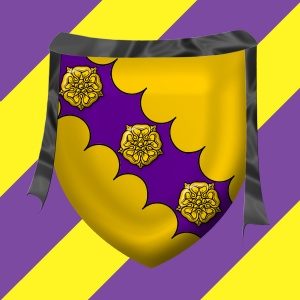
On February 15th, Lady Jutte Roose van der Brugghe of Heraldshill (aka Royse Meingnes) died surrounded by her family after a battle with leukemia complicated by Covid.
From her daughter, Saerlaith ingen Chaicher: “Today is a very sad day in our family. Ruth Thorson, a wife, a mother, a grandmother, a sister, and a friend has sadly passed away. She left us today after a very tough battle. We were able to see her and tell her that we loved her dearly before she took the leap into the great unknown. We are all better for knowing her and enjoying the small and great pleasures that she gave us. She was always there to kiss a boo boo or when things were tough for us to help us through our troubles. There are tough days ahead knowing that there is a great hole in our hearts that nothing can fill. All we can do is live on and honor her until the day that we can meet again and wrap our arms around her again. I miss you mom already.”
Jutte’s device, “Or on a bend engrailed purpure three roses Or”, was inspired by her love of roses and her three children.
Her first event was Gulf Wars: “TBT -March 2005 – My first contact with Calontir and SCA. Daughter pleaded with me to attend Gulf Wars with her. You didn’t know me but immediately invited me in and put a plate of food and a tankard of something in my hands. Most generous and fun group of people I had ever met! Been a card-carrying member ever since. Huzzah Calontir!”
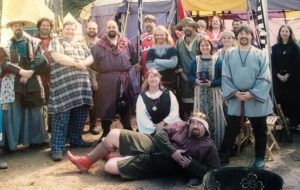
The next spring, Jutte joined the ranks of wet and cold Hillians for Military History Days in Charles City, Iowa. “I can’t remember feeling more cold, wet, and miserable in my whole life! And it was a blast! I felt so proud showing my hometown what my Shire represents and what we do.”
Jutte’s favorite part of the SCA was the fellowship she enjoyed with the other members. Many was the time you could find her milling through the merchants ostensibly checking on her merchant husband, Thorir, sharing coffee and cribbage at Odyssey Coffee, sitting around the campfire sampling the many fine potables made by fellow SCAdians, or telling one of her many “…there I was” stories.
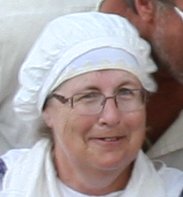
“Just read a comment from another kingdom’s FB page. The person was asking about language that would be confusing to a newcomer. Brought back memories of the very first comments that I heard at my very first meeting. Two people were laughing and discussing how a fighter slid down a hill on his “scutum”. I misheard and couldn’t figure out what was so funny about what must have been a painful expedience. I still smile at that memory.”
Jutte enjoyed creating new garb, drumming, embroidery, needlework, stained glass and wire weaving. At Lilies War 2006 she stayed in a period pavilion of her own devising: a circular brown pavilion with gold trim all around the edge. “When you try to explain to non-SCAers about camping, they usually groan and say negative things. They don’t understand. When I camp, I like comfort. I like to be able to sit in my little home away from home on a rainy day and relax… I made it myself using a 12-foot market umbrella from Sam’s. I think the whole thing cost me $125! Couldn’t afford store-bought, but it was cozy. Some people just put up their tent, throw in the bed and the ice-chest and go. Not me, even though I have gotten some groans and head-shaking from hubby about all the extra stuff.”
Jutte suffered an unfortunate shock during that same Lilies War when she witnessed her son, Iames, die in battle for the first time. “Aaach…but it was a wee wound and he was resurrected! What mother could ask for more!”
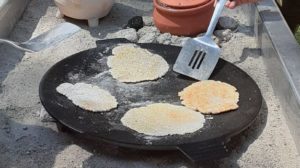 She tried archery, but it turned out that somehow, even though she was right-handed, she was left-eye dominant so that didn’t work out so well. Jutte enjoyed the research aspect of the SCA the most, including researching her Scottish and Flemish personas. “If I am on a quest to try something new, I enjoy spending hours finding out more about it.” About the only thing that she had no desire to do was to cook. “Nope, don’t want to. Can’t make me!” And yet when we did make her, the outcome was delicious. Her Viking fløtbrød was especially addicting.
She tried archery, but it turned out that somehow, even though she was right-handed, she was left-eye dominant so that didn’t work out so well. Jutte enjoyed the research aspect of the SCA the most, including researching her Scottish and Flemish personas. “If I am on a quest to try something new, I enjoy spending hours finding out more about it.” About the only thing that she had no desire to do was to cook. “Nope, don’t want to. Can’t make me!” And yet when we did make her, the outcome was delicious. Her Viking fløtbrød was especially addicting.
Jutte officially served her Shire and Kingdom as a voice herald, event steward, list mistress and group seneschal, but she served in so many other ways great and small. From Brigida von München, “I know I have a lot of wonderful friends, but I need to single out Jutte van der Brugghe, Juliana Macnayre, and Anastasia da Carrara. I had asked Jutte to revive her bookmaking skills for my [Pelican] ceremony on Saturday. She made the book and did the illumination, Juliana did the lovely leatherwork, and Stasi did the lovely calligraphy… Ladies, know that I’m stunned by your work and collaboration!”
The family is planning a memorial in the spring.
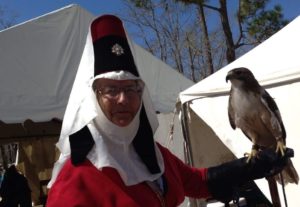
Heraldic Wills and Letters of Permission to Conflict
This is the ninth in a series of educational articles about heraldry for Calontir. (See bottom of page for links to previous articles.)
The previous article in this series discussed “conflict” – the rule that no two people in the SCA can have names or armory that are too similar to each other.
On a regular basis, someone trying to register a new item will discover it conflicts with an item that has already been registered. But all is not lost. If you can track down the owner of the item that conflicts, you can ask for a “Letter of Permission to Conflict”. They don’t have to give you permission, of course, but a lot of times they will. (You might request a letter preemptively, if you’re not sure if your item conflicts or not.)
Some people have been kind enough to file “Blanket Letters of Permission to Conflict” with the College of Arms which is nice to save hassle in the future. Even with Permission, no one can register a name or device that is exactly like yours.
On a related note, the names and heraldry registered with the SCA are considered legal property, and the SCA has committed to protect your heraldic property in perpetuity.
So what happens to your registered names and armory when you die? Their ownership passes to your legal heirs. This may be fine, or you might prefer someone else in your biological or adopted SCA family inherit your items. Some people choose to completely release their heraldic items from protection when they die, or release some of them. Others designate their Kingdom Herald as their heraldic heir so that Letters of Permission to Conflict can be issued as needed.
You can do any of these things by filing a Heraldic Will with the SCA College of Arms. There is no fee for this.
There are sample letters and wills here: http://heraldry.sca.org/admin.html#APPENDIXD
As always, there are lots of “Heraldic Helpers” to guide you through all this.
At your service,
Sofya la Rus, Habicht Herald
Calontir Heraldic Education Deputy
habicht@calontir.org
Previous articles in this series:
How do I create a coat of arms? Part one: inspiration.
How do I create a coat of arms? Part two, design principles.
How do I create a coat of arms? Part three, ingredients.
Conflict is bad (in Heraldry and elsewhere)
This is the eighth in a series of educational articles about heraldry for Calontir. (See bottom of page for list of previous articles in this series)
Hopefully at this point, you have developed some ideas for your name and/or your heraldry. But before you fall in love with one of them, it’s a good idea to make sure you don’t conflict with (are too similar to) someone else.
Names conflict if they look or sound too much alike. It would be awkward if a herald called your name in court and someone else answered the call. Most of the time, no other name is even close, but sometimes it’s tricky to decide if your name is different enough from name that has already been registered.
Items of armory conflict if they look too much alike. There are actual period guidelines for this, called marks of cadency. A mark of cadency would be a small change that a son would make to the family coat of arms to show he was related to the head of the family, in SCA-speak that’s a “distinct change”. So your device needs to be enough different from someone else’s, that you’re not implying that you’re their heir.
Over the years, heralds have come up with a system of what counts as a major change (significant change or SC, just need one), minor change (distinct changes or DC, need two) and what doesn’t count at all for difference – based as much as possible on period research.
Go here to see what names have already been registered (check multiple different spellings of each of the parts of your name): https://oanda.sca.org//oanda_np.cgi
Here are the official rules about names conflict: SENA PN.3. Personal Names Conflict – http://heraldry.sca.org/sena.html#PN3
Go here to look up what other coats of arms have been registered with your charges: https://oanda.sca.org/ordinary/
Here are the official rules about armory conflict: SENA A.5. Armory Conflict – http://heraldry.sca.org/sena.html#A5
Articles to explain the rules: http://scaheraldry.info/index.php?title=Conflict_Checking
Admittedly, “conflict” is one of the most challenging parts of researching names and heraldry. Even experienced heralds get confused, argue, and miss things (a lot), but you can at least start the process and get ideas for what other people have done.
As always, there are lots of “Heraldic Helpers” to guide you through all this (see article below).
At your service,
Sofya la Rus, Habicht Herald
Calontir Heraldic Education Deputy
habicht@calontir.org
Previous articles in this series:
How do I create a coat of arms? Part one: inspiration.
How do I create a coat of arms? Part two, design principles.
How do I create a coat of arms? Part four, embellishments.
This is the seventh in a series of educational articles about heraldry for Calontir. (See bottom of page for links to previous articles.)
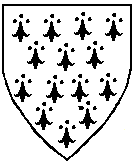
Previously, we discussed the basic ingredients for a coat of arms. Now how can we embellish those basic ingredients?
Furs.
Furs are treated like tinctures in most ways. The most common fur in heraldry is ermine. Plain ermine is black ermine tails on a white background, but versions can be done using all the heraldic tinctures.
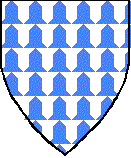 Vair is another fur, meant to mimic squirrel fur, and is traditionally blue and white, but can be done in other tinctures also. Furs obey the contrast rules, so you can have red ermined white, but not red ermined green.
Vair is another fur, meant to mimic squirrel fur, and is traditionally blue and white, but can be done in other tinctures also. Furs obey the contrast rules, so you can have red ermined white, but not red ermined green.
Lines of Division
The field (background) of a device, and many charges (motifs) can be divided into different-colored pieces. These pieces do NOT have to obey the contrast rules if they’re simple enough to be identifiable. (This because the color is considered “next to” the color, not “on” the color, i.e. you’ve divided layer 1 into different colored pieces, not placed a dark-colored layer 2 ON a dark-colored layer 1.)
Here are some options:
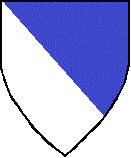
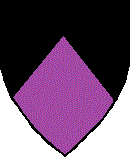
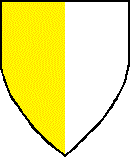

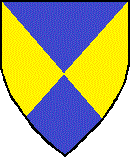
Complex Lines
The lines of the above divisions don’t have to be straight line, and these complex lines can also be applied to the edges of some simple geometric charges.
Here are some examples:









Diapering
In heraldry, diapering is adding tone-on-tone patterns to embellish an otherwise plain area of a device. For example, a plain blue background can be dressed up with light blue foliage swirls.
As you can see, even with all the rules in heraldry, there are millions of amazing options available. We’re happy to help if you can’t make up your mind. (See “Heraldic Helpers“.)
At your service,
Sofya la Rus, Habicht Herald
Calontir Heraldic Education Deputy
habicht@calontir.org
Previous articles in this series:
How do I create a coat of arms? Part one: inspiration.
How do I create a coat of arms? Part two, design principles.
Retirement of the Unofficial Calontir Google Calendar
HL Allison has made some great technical updates to the Kingdom Calendar, so it now integrates with Google calendar (along with Timely, Outlook and Apple).
The Subscribe button is at the bottom of the calendar page – https://calontir.org/events/
With that in mind, I am going to retire the unofficial Calontir Google calendar after 11 (!) years and shift to helping with the official calendar.
Thank you.
Mistress Sofya la Rus, OL
Shire of Heraldshill
How do I create a coat of arms? Part three, ingredients.
This is the sixth in a series of educational articles about heraldry in Calontir.
Previously, we discussed inspiration and general principles for your coat-of-arms. Now lets look at the key ingredients.
Tinctures
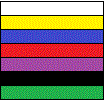
“Tincture” is the term heralds use for color. There are seven standard tinctures used in heraldry. Technically, the term “color” is only for the darker colors: blue, red, purple, black and green. The term “metal” is used for the light colors: white and yellow (aka silver, gold). The only time we can use other colors like orange or brown is if they’re the natural color of the object, such the wooden handle of a hammer.
Contrast
Identifiably requires good contrast, so we need to avoid putting dark things on a dark background (color-on-color) and light things on a light background (metal-on-metal).
Layers.
The 1st layer of your design is the background. Heralds call it the field. It is possible to have a coat of arms that is just a field!
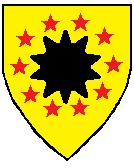
The 2nd layer is made up of the primary, secondary, and/or peripheral charges.
Primary charges are the main motif/s in the central area of the shield, whether a stripe down the middle or a dozen caltrops scattered on the field.
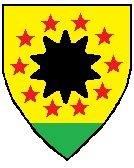
Secondary charges are motifs around the primary charge, for example a circle of stars around a sun. This gets tricky, because that same circle of stars becomes the “primary charge group” if we remove the sun from the design.
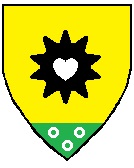
Peripheral charges are motifs that are part of the edge of the shield such as a border or, in this case, a base. They can never be a primary charge because they can never be in the central area of the shield. It is possible to have a coat of arms that only has peripheral charges on the field, so they are different from secondary charges.
The 3rd layer is made up of the tertiary charges. Tertiary charges are motifs that are layered on other motifs, such as rings on a base or a heart on a sun. [Quaternary charges are not allowed.]
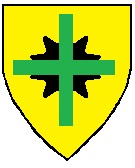 Overall charges are special. They’re a bit like overgrown tertiary charges that overlap the field. They have weird rules because of that, and it’s hard to make good designs with overall charges – they have to overlap the field enough, they can’t cover up too much of the other charges, etc. In this case, it’s hard to see that there’s a sun hiding underneath the cross.
Overall charges are special. They’re a bit like overgrown tertiary charges that overlap the field. They have weird rules because of that, and it’s hard to make good designs with overall charges – they have to overlap the field enough, they can’t cover up too much of the other charges, etc. In this case, it’s hard to see that there’s a sun hiding underneath the cross.
If this is starting to get confusing, there are lots of resources to help. See “Heraldic Helpers“, come meet us at a consult table near you, or try out the Virtual Consult Table!
At your service,
Sofya la Rus, Habicht Herald
Calontir Heraldic Education Deputy
habicht@calontir.org
How do I create a coat of arms? Part two, design principles.
This is the fifth in a series of educational articles about heraldry in Calontir.
Previously, we discussed where to get inspiration for your coat-of-arms. Now that you have some ideas, let’s talk about how to put it all together.
Some important design principles to keep in mind:
Duct-tape heraldry. Aka who’s going to draw this for you? Be considerate of whoever is going to be sewing your heraldic design on your tabard. There’s no shame in designing good solid heraldry that can be laid out on your shield using duct tape in a pinch.
Identifiability. The original purpose of heraldry is to identify you across a battlefield. So the colors are bright, the contrasts are clear, and the designs are relatively simple. Charges (motifs) tend to be drawn in order to make the key identifying features of the object obvious. For example, the eagle is shown with its wings displayed on either side.
Stylized and Simplified. Heraldry is a bit like cartoon art. Things are not necessarily drawn realistically, or painted their natural colors. Heraldry has it’s own visual language with defined poses for animals and simplified depictions of objects. That’s why it’s so useful to study period armorials for inspiration.
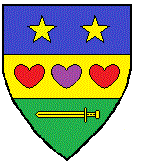
Complexity. We are limited to a complexity count of 8 or less – adding up the number of colors with the number of charges. So a red shield with a white owl has a complexity count of three: two colors (red & white) and one charge (owl). A half-blue and half-green shield with a gold stars and a sword on either side of a gold stripe with purple and red hearts has a complexity count of nine – with five colors (blue, yellow, purple, red, green) and four charges (stars, stripe, hearts, sword). As you can see, it’s a little much.
Contrast. Identifiably requires good contrast, so we need to avoid putting dark things on a dark background (“color-on-color”, eg. blue on red) or light things on a light background (“metal-on-metal”, eg. yellow/gold on white/silver) in most situations.
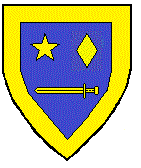 Slot machine. Having 3 or more different things in the same area of the shield doesn’t match period practice and is also poor design. You shouldn’t have a star, a diamond and a sword in the same group on your shield. If you have to have them all, separate them into different sections of the shield. (More on this in the next article.)
Slot machine. Having 3 or more different things in the same area of the shield doesn’t match period practice and is also poor design. You shouldn’t have a star, a diamond and a sword in the same group on your shield. If you have to have them all, separate them into different sections of the shield. (More on this in the next article.)
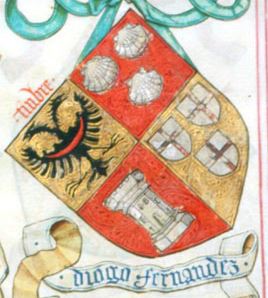
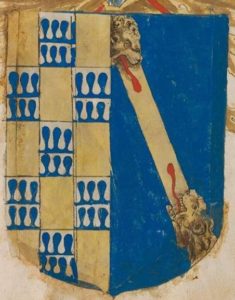 Marshalling. Marshalling combines the arms of two or more families to display noble lineage. Since we do not inherit nobility in the SCA, marshalled designs cannot be registered. There are two types of marshalling: impaling and quartering. Impaling is when a shield is divided down the middle with one family coat of arms on the left, and another on the right – originally to show off that both of your grandfathers were important. Quartering was an alternate way to show off your grandfathers, or you could show your 4 great-grandfathers’ arms in each of the sections. Note that we can display heraldic designs that look like marshalling. For example, a couple might marshal their arms as a “marital badge” to mark their children at an event to help people return them. That’s a great use of heraldry, just not registerable.
Marshalling. Marshalling combines the arms of two or more families to display noble lineage. Since we do not inherit nobility in the SCA, marshalled designs cannot be registered. There are two types of marshalling: impaling and quartering. Impaling is when a shield is divided down the middle with one family coat of arms on the left, and another on the right – originally to show off that both of your grandfathers were important. Quartering was an alternate way to show off your grandfathers, or you could show your 4 great-grandfathers’ arms in each of the sections. Note that we can display heraldic designs that look like marshalling. For example, a couple might marshal their arms as a “marital badge” to mark their children at an event to help people return them. That’s a great use of heraldry, just not registerable.
Contact me or one of the many other heralds of Calontir for further details. (See “Heraldic Helpers”)
At your service,
Sofya la Rus, Habicht Herald
Calontir Heraldic Education Deputy
habicht@calontir.org
How do I create a coat of arms? Part one: inspiration.
This is the fourth in a series of educational articles about heraldry in Calontir.
Now that you have a useable name, you need some heraldry to go with it.
We’re lucky that we get to design our own coats of arms. In period, you would have been stuck with whatever your great-great-granddad decided to slap on his shield the night before the big battle that made him famous. So historical coats of arms did not have “deep personal meaning”, just layers of family honor. Period nobility had to resort to badges and impressa when a new generation wanted add a personal stamp to their heraldic identity.
Which brings up the question of devices vs arms vs badges. Your device is what you would put on your shield, your tabard and your banner in order to say “I am here. This is me.” Your “device” magically becomes your “arms” when you are given an “Award of Arms” by the Crown.
Your badge is used to mark your followers, children and your property in order to say, “This is mine.” (An impressa is an heraldic-ish design that a late period noble would use to express “deep personal meaning” for special events.)
It can be fun to have your heraldry match your persona (or your great-great-grandad’s persona). We now have lots of period armorials (collections of coats-of-arms) on-line: German, Italian, English, French, Spanish, etc. Here’s one place to start:
“An Annotated List of Period Armorials Available Online“
Even if you don’t plan to match your heraldry to your persona, it’s great to browse through period armorials for ideas. (If you find a design you like, it’s smart to write down where you found it. Some period heraldry “breaks the rules”, but we can get around that if you have the documentation.)
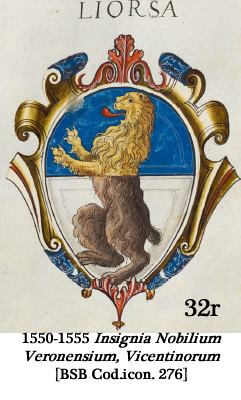
You may notice that a lot of period arms are “canting arms”. A “cant” is a pun so, for example, the Talbot family had an image of a dog (a talbot) on their coat of arms. This is great for SCA heraldry, too. Names in period often have different meanings than we would assume, so that’s fun to research.
Be careful about resume heraldry. You may be a brewer, a weaver, and a fighter, but trying to work in a barrel, a loom and a rapier on your shield will be messy. Try to trim your “resume” to one main thing or get more subtle. Symbolize your fighting with an embattled bordure, or use yellow on your shield to symbolize the mead that you brew.
You don’t have to follow the crowd. Lots of archers have arrows on their devices, but fewer have pheons (fancy arrowheads). Why have a plain old lion when you could have a panther breathing fire? The Pictorial Dictionary of SCA Heraldry is a great resource for the wide variety of charges that have been used in the SCA. And using period documentation, we can register “new” ones!
As always, the heralds of Calontir stand ready to help. (See “Heraldic Helpers“) Bring your ideas to a Heraldic Consult Table at an event or try out the Virtual Consult Table and we’ll help flesh them out!
At your service,
Sofya la Rus, Habicht Herald
Calontir Heraldic Education Deputy
habicht@calontir.org
The Calontiri Wiki has Moved!
The Calontiri Wiki was started 4 years ago in order to:
- Help to get to know our fellow Calontiri better – interests, skills, personas, put names to faces
- Make it easier to submit well-informed award recommendations
- Help bring distant parts of our Kingdom together
- Let our various guilds and households make their own easily updated place on the web
- Give Calontiri merchants another venue to spread their craft
- Be a place to find the stories and songs that explain what it is to be Calontiri
- And whatever else we want to do with it!
Since then, the wiki has grown to over 1200 files, including over 700 articles about citizens of Calontir!
Unfortunately, the wiki farm that was hosting the Calontiri Wiki is closing down. Fortunately, Master Mathurin was kind enough to make room for it where he hosts the Falcon Banner.
So after a massive crash course in web development, hours of help from an old college buddy, and lots of help from fellow Calontiri wiki fans, the Calontiri Wiki has been migrated to it’s new home:
http://calontiri.info (note the “i” at the end of calontiri)
There’s still lots of polishing up to do, and not all the images migrated over so that’s where you can help.
If you had an article on calontiri.wikispaces.com, search for your article on calontiri.info and make sure it looks okay. Search for your friends, too. The old wiki will be up until the end of September for reference.
There is an article with Basic Instructions in the left toolbar to help.
If you want an account, let me know. If you don’t have an article yet, and want one, let me know.
At your service,
Mistress Sofya la Rus, wiki witch
sofya@heraldshill.org or Sofya la Rus (Lisa Sofya Kies) on Facebook

You must be logged in to post a comment.